Rise of the IncaThe growth of the Inca Empire can only be described as meteoric. Though precise dates for its beginnings remain elusive, the realm known to the Inca as Tahuantinsuyu, or "The Four Parts Together," arose sometime in the early 1400s and ended in 1532, when the Spaniard Pizarro captured and executed the final Inca ruler, Atahualpa, dealing a fatal blow to what had been the largest indigenous empire in the Americas. How did the Incas rise so quickly? In this interview, Terence D'Altroy, a professor of anthropology at Columbia University and author of The Incas, describes the diverse and innovative strategies that helped secure the Incas a domain almost as vast as the Roman Empire. Growth spurtQ: Just how big was the empire in its heyday? How far did it extend? Terence D'Altroy: It was about 2,400 miles from north to south. That would take us from the area just at the border of Ecuador and Colombia down to about 50 miles south of modern Santiago, Chile. In terms of square miles, we're probably talking something like 300,000 square miles. In population, estimates range from maybe six to 12 million people; my own estimate would put it somewhere around 10 to 12 million. That would make it perhaps the biggest empire in all of the indigenous Americas before the Spanish arrival. Q: So how quickly did it grow? What were the dates from its advent to its apogee, roughly? D'Altroy: Recent archeological research suggests that the Incas actually had a fairly potent state-level society in the Cuzco area that took about 200 years to develop and that the empire as an expansionist polity probably started early in the 15th century, that is, sometime fairly soon after 1400. So the empire itself was maybe a century or a little bit longer in duration. But the processes by which the Incas came into power were really much longer term than the historical documents would lead us to believe. Q: I'd like to get into more specifics in a moment, but in a general sense, how did the Inca Empire grow so rapidly? D'Altroy: There were probably three or four things that the Incas did simultaneously. One, they worked very hard in diplomacy, negotiating relationships with neighbors or with people who were targets for incorporation into their expanding territory, and they tried to work out amicable relationships through gift exchanges, marital exchanges, or political alliances. Failing that, they would threaten those people with military conquest, and that having failed, they would actually undertake military conquest. So there was a combination of diplomacy and inducement, coercion, and militarism all wrapped up into one strategic package. Leading the wayQ: How much was the empire's rapid growth due to the exploits of a single great leader, the Alexander-the-Great-like Pachacuti? Actually, to two great leaders, Pachacuti and his son Tupac Inca Yupanqui? D'Altroy: Well, it seems likely that Pachacuti and Tupac Inca Yupanqui were instrumental in the great expansion of the empire. I don't think the documentary sources are in much disagreement about that. So we can think of the expansion of the empire as being largely a product of a couple of generations. The question is, how much of the organizational capacity for the expansion developed before Pachacuti came along? Some people think that the Incas had actually been developing that capability over between four to six generations. Other people think that Pachacuti basically created things on his own. If we can draw an analogy, if we think of the exploits of Alexander the Great, who's thought of as being one person who created a great empire basically on his own, we have to remember that his father, Philip of Macedon, had actually spent several decades developing the military tactics and the political strategies that allowed him to incorporate all of Macedonia and Greece, which became the launching pad for Alexander. "The Incas were simply too powerful to be resisted." Q: Yes, you write in your book The Incas that the conflict characteristic of Peruvian highland society in the pre-Inca period [A.D. 1000–1400] set the conditions for Inca expansion. Can you explain that? D'Altroy: Yes. There are a couple of things that contributed. One of them is that there was so much local conflict that there were, at least in the highlands, no major societies that had the capacity to resist the Incas' advancement. We can't think of any societies that were larger than maybe 40,000 or 50,000 people maximum at the time the Incas began their expansion. There wasn't the kind of, let's say, state-state conflict that you would have seen in other parts of the world. The Incas didn't really have major competitors comparable to their own power until they ran into the Chimú on the north coast of Peru, who actually had an empire. By that time, the Incas were simply too powerful to be resisted. So the local conflict made it difficult for societies of the highlands to ally with one another and resist the Inca advances. Another thing that contributed to the Inca advancement was that conflict had long been honed as a requisite for leadership. So this was not innovative, in that militarism was built into the culture. Q: Is that what you mean when you say in your book that the interplay between militarism and genealogy in Inca successions also contributed to the expansion? D'Altroy: Yes. One of the things we have to keep in mind about the nature of succession to leadership among Andean peoples—and the Incas were definitely included in this—is that there wasn't the concept of primogeniture. That is, the oldest son did not automatically succeed to the throne. Instead, there were potentially a series of candidates whose legitimacy was validated through success. One series of sons or even brothers of the deceased ruler would compete with one another, politically and perhaps even militarily, to take over the position of leader of the society. As a consequence of this, it was really a battle for the strongest, most able person to lead the society. That's a very effective way to create leadership in a people who were trying to expand their power. On the other hand, it can be very destructive in a society in which stability has been reached, because instead of leading to dynamic leadership it leads to factional competition among the leadership, and it breaks down the power of the political structure. Consolidating the empireQ: How much of the Inca leaders' phenomenal success was due to their building on administrative and economic systems that were already in place? D'Altroy: When the Incas developed the empire, they simultaneously used existing structures and innovated. [The late anthropologist] John Murra made an argument some years ago that the way the Incas presented their notion of leadership to the people who they were trying to incorporate into the empire was by saying that they, the Incas, were really nothing more than local lords written on a grand scale. There were mutual obligations, in which the local, non-Inca lord owed hospitality, protection, and military and sacred leadership to the local society, and the society owed its labor and allegiance in return. On the other hand, there was nothing remotely as large as the Inca Empire, and they innovated in a variety of ways. For example, they moved around a large fraction of the population—somewhere in the range of three million people, maybe as many as five million. They did this by resettling people in agriculturally productive areas or in areas that were military hotspots. Or they broke groups up as a means of diffusing the potential for political insurrection. The other thing the Incas did that was innovative but that also built on existing systems was to create a vast network of roads, some 40,000 kilometers according to John Hyslop, who's the leading expert on that. They also built around 2,000 provincial way stations or administrative or production centers that were joined by those roads. So they essentially laid a structure of imperial rule on top of an existing system of local societies, and then tried to argue that it was really nothing more than the local community in a grand expansive pattern. Q: How did the Inca strategy of intermarriage with other groups aid them in their rise? D'Altroy: When the Incas were originally forming their power base around Cuzco, they formed alliances with a variety of different ethnic groups through intermarriage, so that the Inca ruler would marry the daughter of a local ethnic leader and then would give one of his daughters in reciprocal marriage to that local leader. So the Incas built themselves up using a combination of kinship and political alliances locally in this way. Once the empire got going, things worked a bit differently. The Inca emperor would marry the daughters of prestigious local lords and bring them in as part of his community. That was a way of essentially elevating the status of the subject lords. But the Incas did not give away their own princesses in the same way to ethnic lords. We find, for example, that the last undisputed ruler of the empire, a man by the name of Huayna Capac, when he went to Ecuador sometime in the early 16th century and developed a new capital and carried out warfare, he took along 2,000 of his wives, leaving the other 4,000 in Cuzco! What we see here is a very conscious strategy of marital alliance being used to solidify political relations. But it became increasingly one-sided as the Inca emperors developed more concentrated power. "Given the chance, people rejected Inca rule at their first opportunity." Q: In the end, did the Inca generally improve the lives of those they conquered or assimilated into the empire? D'Altroy: In some ways, life was much better under the Incas than it had been previously, and in other ways it was, of course, much worse. Let me give you a couple of examples of how things improved. In the highlands, most of the population before the Inca peace lived in relatively high elevations, often in communities away from the most productive agricultural lands in the valley. When the Incas resettled the populations, an awful lot of that population abandoned the high-elevation settlements and moved into places that were more dispersed and more accessible to productive agricultural lands. It made it easier for people to follow their agricultural strategies, to exploit, say, lower maize lands. It probably also had the impact of reducing infant mortality, because the mothers' diets were better, the children were no longer living in such cold environments, and the people weren't compressed into such nucleated communities. There are some indications that infant mortality rates decreased substantially under the Incas. In fact, both the Incas and some subject peoples reported to the Spaniards that family size grew under Inca rule. In addition, there was a reduction in the amount of warfare at a local level. And some people, of course, got great privileges by collaborating with the state. So in those senses, things certainly got better. On the other hand, there was a great trade-off. People owed two to three months of labor on an annual basis, and they lost some extremely valuable productive lands. A third of the population was moved from their traditional homelands into areas that were foreign to them, and they were not well received by the people into whose regions they were inserted. Finally, of course, they lost their freedom and their political autonomy. So there were some benefits, but they were offset by substantial disadvantages. By and large, given the chance, people rejected Inca rule at their first opportunity, so we know which side of that equation they came down on. Roused by richesQ: To what degree did a quest for wealth drive the expansion? D'Altroy: That's a good question. We should think of wealth in maybe three or four different kinds among Andean peoples. Wealth certainly could be measured in terms of mineral wealth, which we know as one of the things that the Incas were very interested in gaining. They thought that gold was the sweat of the sun and silver was the tears of the moon, so they considered those to be sacred rather than monetarily valuable. The real source of wealth for the Incas was human labor. One's ability to command labor, either by having a large family at a local level or by commanding the labor of a large set of people through conquest, really made an individual or polity wealthy. There are other kinds of wealth. Herds of llamas and alpacas were extremely valuable. That's probably why the Incas turned their attention first to the Lake Titicaca area, because that's where the greatest herds of the Andes were located. The llamas and alpacas were status and wealth on the hoof. Wealth also included productive lands, which the Incas were very interested in gaining, and finally things like products of human labor, particularly cloth, which was the most esteemed kind of material good in the empire. By commanding both labor and herds, the Incas could produce the kind of wealth they most valued—very, very fancy cloth. Q: The Inca often gave such valuable textiles and other gifts to those they conquered and threw feasts for them. Would that, again, have contributed to perhaps a quicker and more successful rise than otherwise? D'Altroy: Yes. One of the things the Incas did was to present themselves as benefactors to the entire population. The way they did that was by giving out gifts on a grand scale. One of the names the Inca ruler took on translates from the Quechua as "lover and benefactor of the poor." This was manifested in practical terms by giving the people all the food and drink they needed while they were carrying out their labors on behalf of the state. Of course, that food and drink came from their own labors, but at least they were not required to supply their own resources to sustain themselves while they were carrying out their labor duties. One's status in Andean society was often marked by the kinds of gifts that one received from superiors. The prime kind of gift would be very, very fancy cloth, Cumbi cloth, which was a tapestry weave cloth. The most ornate of such cloths were made out of things like hummingbird feathers or little shells, but more often they were made out of camelid wools. Vicuña wool was the finest. There were lots and lots of different grades of prestige goods that could be given to mark one's service to the state or one's status. The Inca also went to great lengths in public ceremonies to sustain the population. They threw great beer bashes, and they gave away gifts as a way of trying to reinforce that sense of mutual allegiance between the state and the people whom they were governing. "We'll always be in a position of not really being secure about Inca history." Q: The Incas also had an elaborate food storage system. How much did that play into their success? D'Altroy: The storage system was the linchpin between production and consumption for the Andean peoples, not just the Incas but also local societies. Just to give you an idea of the scale involved, at least according to some reports, the Incas in Cuzco [the Inca capital] received all of their food either every four days or on a daily basis from the state storehouses. Around 20,000 to 50,000 people were regularly supplied. The largest storage system was right around Cuzco itself, but if you go out into the provinces, that's where the bulk of the storage in the empire was located. There were some places, such as Huánuco Pampa, Peru or Cochabamba, Bolivia or the upper Mantaro Valley in Peru, where there were anywhere from 1,000 to 2,500 storage buildings. The kinds of things stored in those facilities ranged from very, very fine raw materials like hummingbird feathers, to sandals for soldiers and shirts for people in service to the state, to foodstuffs. Answering the unansweredQ: In closing, what would you most like to know? What gaps in our understanding of the Incas' meteoric rise would you like filled? D'Altroy: I guess the one thing that I would really like to know is the time frame. That seems like a fairly simple thing to want to know, but one of the things we have to understand about Inca history is that space and hierarchy probably played a more important role in the way the Incas constructed their history than did linear sequences of events. And we know that the Incas played with their histories, that each of the different royal kin groups in Cuzco had its own version of Inca history, and they were competing with one another. The past was malleable, with the goal of legitimizing a particular political present. So what I'd really like to know is, exactly how long did the Inca state take to form and exactly how long did the Inca Empire take to expand? So that we get a sense of exactly how to read these very different versions of what the Inca past had been, as told by the different groups of Incas themselves. Q: Where do you think you'll find that, in archeological work or historical documents or perhaps in some other avenue of research? D'Altroy: We're working with archeological evidence and chronometric dating—radiocarbon dating in particular has some possibilities. Rereading the documents has other possibilities. One of the problems with radiocarbon dating is that it's a probabilistic way of measuring the past. You have to bracket to some degree of probability a period of time within which you think something happened. So
we'll always be in a position of not really being secure about Inca
history. We don't know when particular events happened; we don't
know the precise sequence of things. We don't have histories such as the
Romans, the Egyptians, or the Akkadians had. We're in a position of
trying to retrodict, that is, to work backwards into the past and read history
and archeology and try to put them together in a synthetic package.
That's a problem we're still working on and will probably be
working on for some time.
|
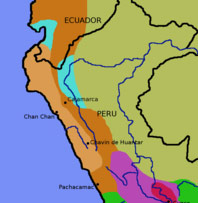
By 1532, when Pizarro invaded, the Inca Empire stretched from what is now southern Colombia all the way to central Chile. 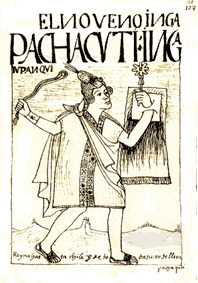
The Inca leader Pachacuti, as depicted by an early chronicler. According to a 1586 chronicle by the Spanish cleric Miguel Cabello Valboa, Pachacuti reigned from 1438 to 1471 and his son Tupac Inca Yupanqui from 1471 to 1493, though these dates remain controversial. 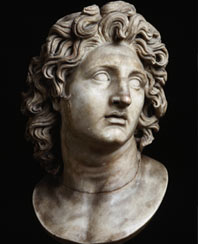
Pachacuti was an Inca version of Alexander the Great (above), who created a vast empire very rapidly in part by building on the efforts of those who came before him. 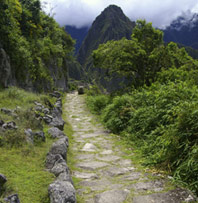
Inca roads, like this one to Machu Picchu, extended for a total of 25,000 miles at the height of the empire. 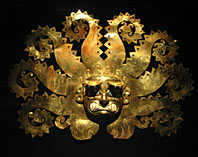
Like the Spanish, the Inca coveted gold, though for different reasons than their conquerors. Above, an ancient Peruvian mask. 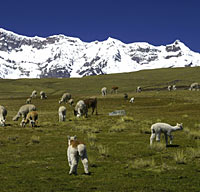
Camelids like llamas and alpacas were "wealth on the hoof" for the Inca, D'Altroy says. Above, Ausangate Mountain in the Peruvian Andes. 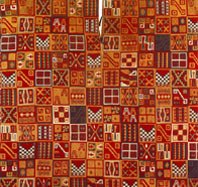
In Inca society, fine textiles like this Inca cloth made around 1550 were the most highly valued product of human labor. 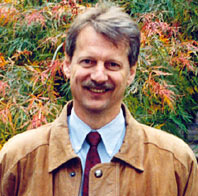
"The past was malleable," says Terence D'Altroy, who hopes through archeological and other means to get a firmer idea of just how fast the Inca Empire grew. |
|
Interview conducted on May 17, 2007 and edited by Peter Tyson, editor in chief of NOVA online The Great Inca Rebellion Home | Send Feedback | Image Credits | Support NOVA |
© | Created June 2007 |
|
|
|
